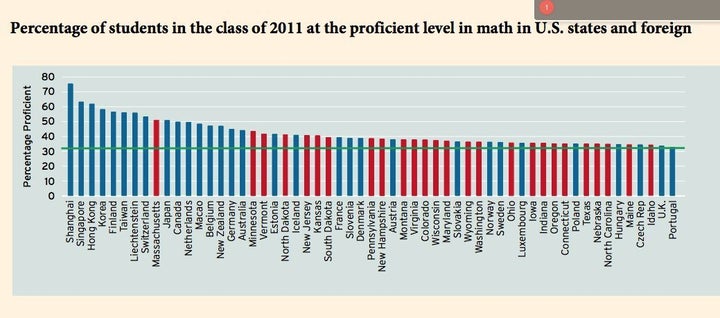
U.S. students rank poorly in proficiency on both domestic and international math exams, a problem that could cost the country $75 trillion over 80 years, according to a new study.
U.S. students fall behind 31 countries in math proficiency and behind 16 countries in reading proficiency, according to the report released Wednesday, titled "Globally Challenged: Are U.S. Students Ready to Compete?"
The relatively low performance should sound a warning, said study author, Paul Peterson, a Harvard government professor who directs the school's Program on Education Policy and Governance and edits the journal Education Next.
"If we're going to grow at the rate that we hope to grow at to address the many issues that exist in our society, we need to have a powerful educational system that is producing a highly proficient workforce," Peterson said.
He pointed to President Obama's recognition of this fact: "We need to out-innovate, out educate, and out-build the rest of the world," Obama has said.
The report looked at the performance of students who graduated high school in 2011 on two tests: the 2009 Programme for International Student Assessment (PISA), the exam administered by the Organization for Economic Cooperation and Development, and the 2007 National Assessment for Educational Progress (NAEP), a national exam considered the gold standard in testing.
The analysis focused on mathematics, Peterson said, because "math skills are the most significant for economic growth."
Instead of simply ranking the countries by mean PISA scores, the report was able to compare countries by the percentage of students deemed proficient by NAEP's standards.
The report hypothesized that since 32 percent of American students performed at the "proficient" level on NAEP's math exam, the same would hold true for PISA. So the authors calculated the score on PISA that would determine proficiency by NAEP standards and then calculated the percentage of students in each tested country that performed at or above that level.
Korea, Finland, Switzerland, Japan, Canada and the Netherlands all performed at a rate higher than 50 percent proficient by NAEP standards. The U.S., with its 32 percent proficiency rate, ended up ranking 32nd out of the 65 tested countries.
Of all 50 U.S. states, only Massachusetts had half or more of its students performing at or above the NAEP proficiency mark. Mississippi ranked lowest.
"If all the students in the United States were educated" at the same level as Massachusetts' students, Peterson noted, "this would not be such a problem."
Analyses of PISA scores show that white and economically privileged students in the U.S. outperform all other groups internationally -- a fact that is often used to claim that the consequences poverty and diversity are keeping many American students behind, and dragging down the country's composite scores. But Peterson said that while controlling for these factors boosts the U.S.'s relative standing, it still doesn't put the country's students close to the top.
For example, Peterson pointed to the difference in performance between the U.S. and Canada, which had 49 percent of its students test proficient in math. "It's a dramatic difference ... for two countries that appear to be at the same level of economic development," Peterson said.
When the report looked at the performance of white U.S. students in isolation, it found 42 percent them proficient -- still 25 percentage points lower than the proportion of all students in Finland and Korea deemed proficient.
Selecting for only the percentage of proficient U.S. students who came from households where at least one parent held a Bachelor's degree would have boosted the country's ranking to 16th place.
"There's a serious problem here, and it's not just [because of] some families [with] parents that aren't that well educated; it's not just that we have a minority population," Peterson said. "There's a much more general problem than that."
The purpose of the report, Peterson said, is to raise the alarm on the U.S.'s educational standing.
"It's unfair to our own students not to give them the skills required to compete in our modern society," he said.
The report concluded the U.S. could increase GDP growth per capita by enhancing its students' math skills. According to the report, over an 80-year period, gains from increasing the percentage of proficient students to Canadian or Korean levels could yield $75 trillion:
Increasing the percentage of proficient students to the levels attained in Canada and Korea would increase the annual U.S. growth rate by 0.9 percentage points and 1.3 percentage points, respectively. Since long-term average annual growth rates hover between 2 and 3 percentage points, that increment would lift growth rates by between 30 and 50 percent.
"Those who say that student math performance does not matter are clearly wrong," the report concludes.